Heliconia: [Cultivation, Irrigation, Associations, Pests and Diseases]

Important points when planting Heliconia
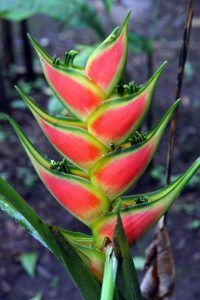 Where to sow? A lot of light. It does not need direct sunlight. Half shade.
Where to sow? A lot of light. It does not need direct sunlight. Half shade.- When? In spring-summer.
- How do we prepare the land? Removed, removing weeds. With 60% mulch substrate with 30% perlite and 10% earthworm humus.
- How do we water? By sprinkling.
- How often do we water? Every two to 3 days in summer. Rest of the year frequently, without excess.
- Plagues and diseases? thrips,aphids, spider mites and nematodes. Botrytis, Achromobacter, Bacillus, Micrococcus and Pseudomonas.
![]() Heliconia is a perennial, rhizomatous herbaceous plant native to the tropical regions of South America, Central America, the Pacific Islands, and Indonesia.
Heliconia is a perennial, rhizomatous herbaceous plant native to the tropical regions of South America, Central America, the Pacific Islands, and Indonesia.
It is popularly known as platanillo, bird of paradise (but not to be confused with Strelitzia), lobster claw or simply heliconia.
The bracts of the heliconias are the most showy organs of the plant, they are generally of primary or mixed colors. Its height varies from 70 cm to 10 m.
The heliconia genus is made up of about 100 species and the most popular are Bihai heliconia, Heliconia rostrata and Heliconia psittacorum.
When to sow the heliconia?
The optimal temperature for its development is 28ºC with a range between 25 and 32ºC, they do not support frost and they do not produce flowers when they exceed 35ºC.
The heliconia multiplies by seeds or separation of shoots in spring-summer.
Where to do it?
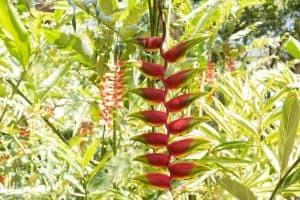 Heliconias are not affected by photoperiod and their flowering depends on temperature. They should be planted in full sun or in areas where most of the day they are illuminated by sunlight.
Heliconias are not affected by photoperiod and their flowering depends on temperature. They should be planted in full sun or in areas where most of the day they are illuminated by sunlight.
In areas with incidence of winds, it is advisable to use windbreaks to counteract its effect and favor the growth of heliconia.
How to prepare the land?
Heliconia requires fertile but well-drained soil, preferably acidic. A mixture of 60% mulch with 30% perlite and 10% earthworm humus.
The soil to be used must be free of stones and clods to facilitate good root development. The ratio of soil to decomposed organic matter is three to one.
It can be generalized within certain ranges that the nutritional aspects of Heliconias and Alpinias are very similar to those of Musaceae, where nitrogen (N) and potassium (K) play an important role in normal growth and commercial production.
Most of the species are highly susceptible to potassium deficiency, they do not tolerate basic soils, nor those with poor drainage.
How do we water the heliconia?
![]() The heliconia lives and develops in the rain forests; They do not resist drought. Due to the size of their leaves, they dehydrate easily as a result of direct radiation, so it is sometimes necessary to use sprinkler irrigation.
The heliconia lives and develops in the rain forests; They do not resist drought. Due to the size of their leaves, they dehydrate easily as a result of direct radiation, so it is sometimes necessary to use sprinkler irrigation.
The amount of water depends on the incidence of light, the requirements of the cultivar and the time of year.
Heliconia requires one centimeter of water daily when planted in well-drained soil, 2.5 cm for species growing in more compact soils, and up to 7 liters per plant in production, in summer.
Waterlogging does not go well for heliconias either, since if the soil remained constantly wet during the winter, its roots would be very damaged and it could get sick. Generally, tropical flowers are favored when the humidity is greater than 80%.
How do we sow a heliconia step by step?
![]() To achieve a successful cultivation of heliconias, an adequate method of propagation must be carried out. This includes carrying out cultural work at the appropriate time in order to obtain healthy and good quality plants.
To achieve a successful cultivation of heliconias, an adequate method of propagation must be carried out. This includes carrying out cultural work at the appropriate time in order to obtain healthy and good quality plants.
The first harvest of heliconia can be obtained between seven and ten months after sowing, but the best quality flower is obtained after 12 months.
Sowing heliconia by seeds
- Fill a seed tray with mulch mixed with 30% perlite.
- Sow a maximum of two seeds in each alveolus
- They cover with a thin layer of substrate, and it is sprayed on the surface.
- Water abundantly, but without flooding.
- Place the tray outside, in partial shade.
- They will germinate in about two weeks.
Sowing heliconia by cuttings
- Wait for the suckers to reach an easily manipulated size (about 10-15cm in height),
- Dig around a bit with a small hand hoe and then separate it with a serrated knife.
- Impregnate the base with homemade rooting
- Plant individually in pots.
- Water abundantly, but without flooding.
What favorable associations does it have?
The association of crops of compatible plants produces benefits with respect to their cultivation separately, in addition to the use of light, water and/or nutrients.
Because it is a tropical type plant, it could be favorable to plant it with others of the same species, taking great care of irrigation, fertilization and its location in the sun.
What pests and diseases attack heliconia?
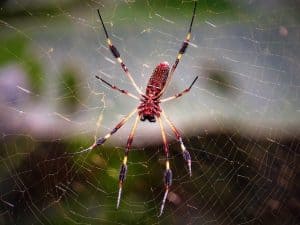 The most common pests in heliconias are: Trips, aphids, red spider and nematodes, among others.
The most common pests in heliconias are: Trips, aphids, red spider and nematodes, among others.
Thrips are small, fast-moving insects that suck sap. They attack the stem of the heliconia, affecting its growth and deforming its flowers.
The green aphid and the black aphid invade the leaves and young shoots, which are seriously affected because these insects suck the sap from the plant.
The red spider can cause significant damage to the heliconia, they are red and feed on the sap of the plants, normally found on the underside of the leaves, in the angles of the veins. The nematodes distort the foliage and stem, the bulbs turn brown, and flowering is late.
If an affected bulb is cut transversely, dark colored rings are seen in the tissue. Among the diseases that heliconias can present are: gray mold (Botrytis cinerea), Achromobacter, Bacillus, Micrococcus and Pseudomonas, causing serious damage to the entire plant.
Bibliography and references
Boris, P. Handbook of Floriculture. 1995. p. 23.
digital database
- Hogarmania.com. Heliconia care. Reproduced from: https://www.hogarmania.com/jardineria/fichas/plantas/heliconia-bihai-26384.html
- Sanchez Monica. the heliconia. Jardineriaon.com. Reproduced from: https://www.jardineriaon.com/heliconia.html
- Ecured.com. Heliconia orthotricha. Reproduced from: https://www.ecured.cu/Heliconia_ortotriche

![Photo of The Leaf: [Parts, Functions, Types]](https://www.complete-gardening.com/wp-content/uploads/2022/08/the-leaf-parts-functions-types-390x220.jpg)
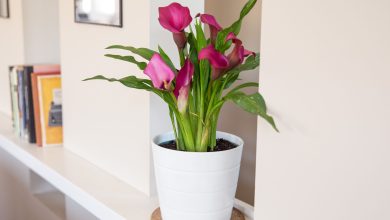
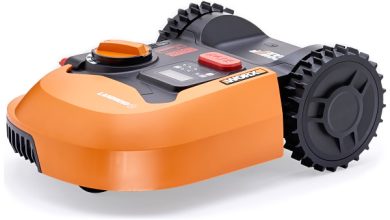
![Photo of Cabbage Caterpillars (Pieris brassicae and Pieris rapae): [Characteristics, Detection, Effects and Treatment]](https://www.complete-gardening.com/wp-content/uploads/2022/08/cabbage-caterpillars-pieris-brassicae-and-pieris-rapae-characteristics-detection-effects-and-treatment.gif)